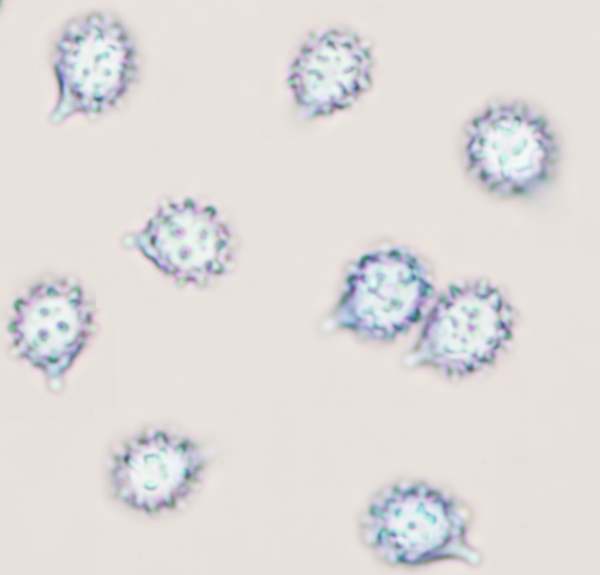Russula sanguinaria (Schumach.) Rauschert - Bloody Brittlegill
Phylum: Basidiomycota - Class: Agaricomycetes - Order: Russulales - Family: Russulaceae
Distribution - Taxonomic History - Etymology - Identification - Culinary Notes - Reference Sources
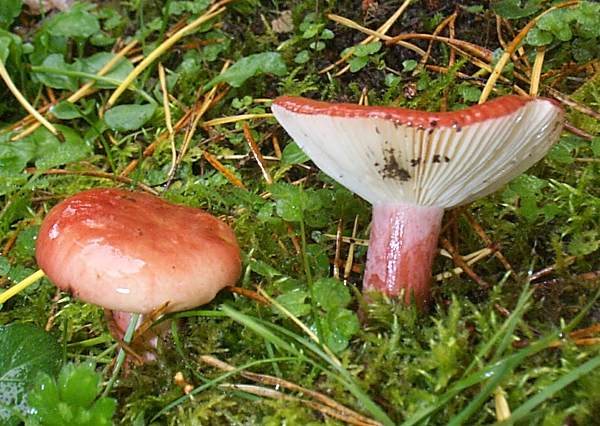
Russula sanguinaria (syn. Russula sanguinea) is an infrequent species found mainly under pine trees. The cap and stem are various shades of red, often with some white areas.
Distribution
The Bloody Brittlegill is widespread and fairly common in Britain and Ireland as well as in many other European countries. There are reports of Russula sanguinaria (or a very similar species) being common and widespread in North America
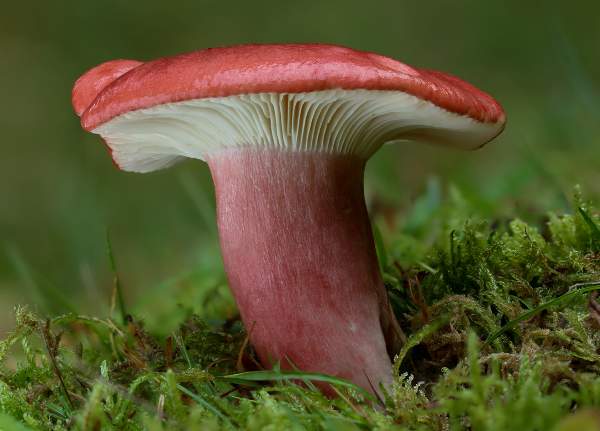
Taxonomic history
This beautiful brittlegill mushroom was first described in 1803 by Danish botanist Heinrich Christian Friedrich Schumacher (1757-1830), who named it Agaricus sanguinarius. (Vast numbers of gilled fungi were dumped into the Agaricus genus in the early days of fungal taxonomy; most have since been moved to other genera leaving in the present-day Agaricus genus a much smaller number of gilled mushrooms that are sometimes referred to as the 'true mushrooms'.) The Bloody Brittlegill was formally redescribed and given its present binomial name in a paper (published in 1989, after his death) by the German mycologist Stephan Rauschert (1931-1986).
Synonyms of Russula sanguinaria include Agaricus rosaceus Pers., Agaricus sanguinarius Schumach., Russula rosacea (Pers.) Gray, and Russula sanguinea var. rosacea (Pers.) J.E. Lange.
(The name Russula sanguinea has been used by many authors referring to this species.)
Etymology
Russula, the generic name, means red or reddish, and indeed many of the brittlegills have red caps (but many more are not, and several of those that are usually red can also occur in a range of other colours!).
The specific epithet sanguinaria comes from the Latin noun sanguis, meaning blood; it refers of course to the blood-like colour of caps and stems of these brittlegill mushrooms.
Identification guide
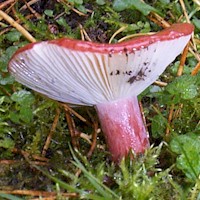 |
Red and purple brittlegills are particularly difficult to identify with certainty without resorting to chemical tests and microscopic examination, but specimens of Russula sanguinaria with red-flushed stems are quite distinctive. Just to make matters more complicated, very occasionally all-white specimens are reported. As ever with mushrooms of this genus, beware of jumping to conclusions based on colour; other features such as taste, smell, habitat and often microscopic structures of spores, cap and gill tissues may have to be examined before a definite identification can be made... and even then be prepared for a few specimens failing to key out at all. |
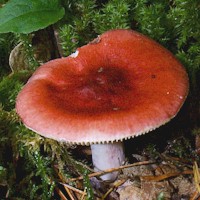 |
Cap4 to 10cm in diameter, the caps are convex at first, becoming flat and often with slightly depressed centres. Blood red or purple-red, often with whitish areas, the cap cuticle easily peels marginally. |
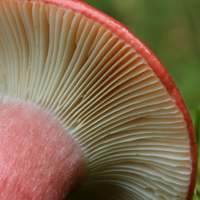 |
GillsAdnexed or slightly decurrent, the narrow, brittle, forked gills are at first cream and then pale ochre, darkening slightly as the fruiting body ages. Stem10 to 30mm in diameter and 4 to 10cm tall, the brittle stems are flushed red or purple. There is no stem ring. |
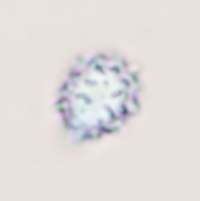 |
SporesOvoid; 7-10 x 6-7.5µm; warts to 0.8µm tall with a few warts joined by connectives but not even a partial reticulum (network). Spore printCream. |
Odour/taste |
Faint fruity odour; somewhat hot and occasionally also bitter tasting. |
Habitat & Ecological role |
In coniferous woodland, mainly under pines. In common with other members of the Russulaceae, Russula sanguinaria is an ectomycorrhizal mushroom. |
Season |
July to October in Britain and Ireland. |
Similar species |
Russula xerampelina is sometimes red with a stem also flushed the same colour; it smells of crab meat. |
Culinary Notes
The Bloody Brittlegill is generally considered an inedible mushroom, because its flesh is rather hot. In any case it is unusual to find more than the occasional scattered group, and so this is not the best of mushrooms to rely on gathering if you are really hungry.
Reference Sources
Pat O'Reilly (2016). Fascinated by Fungi, First Nature Publishing
Geoffrey Kibby (2011).The Genus Russula in Great Britain, published by G Kibby.
Roberto Galli (1996). Le Russule. Edinatura, Milan.
BMS List of English Names for Fungi
Paul M. Kirk, Paul F. Cannon, David W. Minter and J. A. Stalpers. (2008). Dictionary of the Fungi; CABI.
Taxonomic history and synonym information on these pages is drawn from many sources but in particular from the British Mycological Society's GB Checklist of Fungi.
Acknowledgements
This page includes pictures kindly contributed by David Kelly.
Fascinated by Fungi. Back by popular demand, Pat O'Reilly's best-selling 450-page hardback book is available now. The latest second edition was republished with a sparkling new cover design in September 2022 by Coch-y-Bonddu Books. Full details and copies are available from the publisher's online bookshop...
